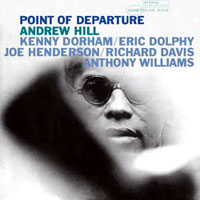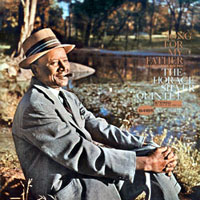Andrew Hill • Point of Departure
Horace Silver • Song For My Father
ne label, two pianist-leaders, two distinctly different musical approaches. Recorded within a year of each other, these two albums showcase the diversity that was a hallmark of later Blue Note recordings. Horace Silver was the consummate Blue Note leader. He was an devotee of the hard bop pioneered by the original Jazz Messengers, of which Silver was a founding member. Andrew Hill, on the other hand, took an approach that was much like that of two other of Blue Note founder Alfred Lion’s eclectic discoveries -- Thelonious Monk and Herbie Nichols. Both in terms of his intricate compositions and idiosyncratic playing, Hill thought outside the musical box, and his albums reflected this. Song For My Father may be Horace Silver’s best-known work. So popular was the title cut that Steely Dan lifted the opening bars for "Rikki Don’t Lose That Number." Silver was in the process of assembling a new group when Song For My Father was recorded. While vibrant young tenor saxophonist Joe Henderson, trumpeter Carmell Jones, bassist Teddy Smith, and drummer Roger Humphries played on nearly all of the tracks, Silver used his previous ensemble --Junior Cook, Blue Mitchell, Gene Taylor and Roy Brooks -- for two of the numbers. Silver crafted a tribute album to his father using the music he grew up with, filtering it through the bossa nova he’d recently heard and leavening it with the hard bop he was already playing. The result was a canny melding that brought Silver as close to a hit album as jazz gets. As its title implies, Point of Departure is the polar opposite of Song For My Father. Hill's use of sidemen such as Eric Dolphy, Richard Davis, Tony Williams, Joe Henderson (who demonstrates his enormous versatility here) and Kenny Dorham keeps one foot firmly in the jazz of the day while stressing the freedom to wander wherever each player's muse took him. The group was the perfect mix of youth and experience. Hill, who by this point was one of Blue Note's staple artists, wrote all five numbers; "Spectrum" best captures what Point of Departure is about. Williams' staccato drum beat opens the track, then Hill wanders in, weaving his way through the melody before veering off in his own direction. Then each of the others gets his turn at doing the same. Dolphy, in particular, is in his element here. The sound of both LPs is excellent, although I’d give a slight edge to the Point of Departure, which is a bit more alive, the instruments a tad more present. But Song For My Father has the better sonic backstory. There was a problem with the opening of the album's first track, which is also the title track. Severe flutter created a couple seconds of audible warble. This was part of every master tape and every issued version of the album, except early original pressings. For the Music Matters release, the track was converted to 24-bit/96kHz digital, at which point sound engineer Jamie Howarth took over, using his Plangent Process to correct the flutter issue. Purists may decry this as ruining an all-analog recording. Well, try as I might, I couldn’t hear a substantive difference between the first track and any of those that follow, and the warble was gone. We finally get to hear the number as Silver intended. The Music Matters gang didn't stop with the music on Song
For My Father. There was no original artwork available, so they scanned the cover of a
mint first pressing, painstakingly correcting issues with it until it looked better
than the original. This care underscores the label's commitment to offering only the
finest Blue Note recordings. They succeed with each release. |


